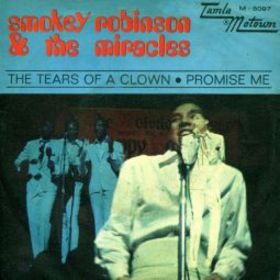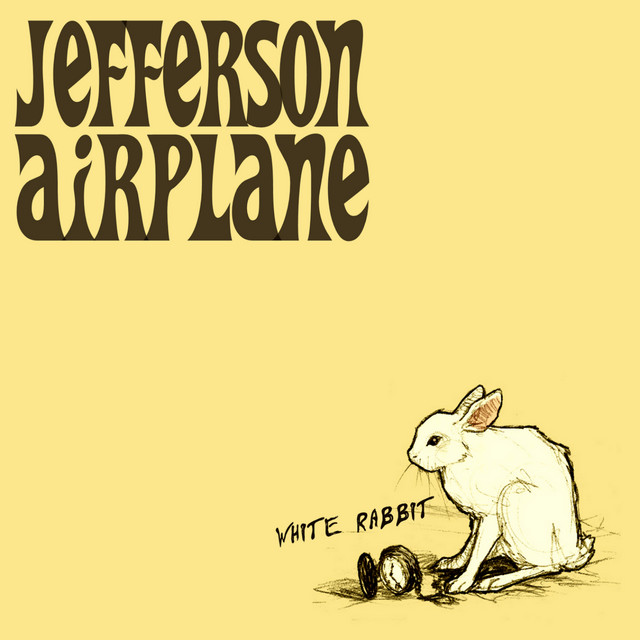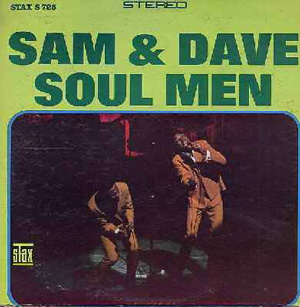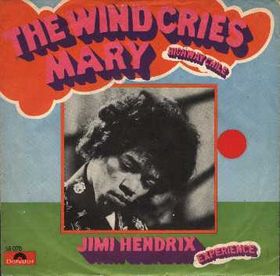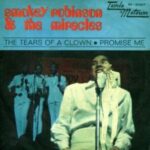 Smokey Robinson’s “The Tears of a Clown,” originally recorded by The Miracles in 1967 and released as a single in 1970, remains one of the most iconic and emotionally complex songs of the Motown era. Combining Robinson’s signature falsetto with lush orchestration, a memorable circus-inspired melody, and poignant lyricism, the track captures the paradoxical nature of outward appearances and inner sorrow. Its intricate blend of joy and melancholy, pop sensibility and lyrical sophistication, makes it both timeless and universally relatable. More than just a chart-topping hit, “The Tears of a Clown” is an enduring example of Robinson’s genius as a songwriter and performer, illustrating his ability to explore the depths of human emotion within the accessible framework of Motown pop.
Smokey Robinson’s “The Tears of a Clown,” originally recorded by The Miracles in 1967 and released as a single in 1970, remains one of the most iconic and emotionally complex songs of the Motown era. Combining Robinson’s signature falsetto with lush orchestration, a memorable circus-inspired melody, and poignant lyricism, the track captures the paradoxical nature of outward appearances and inner sorrow. Its intricate blend of joy and melancholy, pop sensibility and lyrical sophistication, makes it both timeless and universally relatable. More than just a chart-topping hit, “The Tears of a Clown” is an enduring example of Robinson’s genius as a songwriter and performer, illustrating his ability to explore the depths of human emotion within the accessible framework of Motown pop.
Musically, “The Tears of a Clown” is immediately distinctive. Written in collaboration with Stevie Wonder and Hank Cosby, the song fuses Robinson’s melodic sensibilities with a whimsical, almost theatrical arrangement. The opening melody, carried by a syncopated bass line and bright horn stabs, evokes the atmosphere of a circus, yet this lively instrumentation contrasts sharply with the song’s underlying theme of heartbreak. The juxtaposition of upbeat musicality and sorrowful lyrics creates a layered listening experience, where the cheerful arrangement initially disguises the emotional weight of the song, reflecting the very concept of masking pain with outward cheer.
Robinson’s vocal performance is central to the song’s power. His falsetto, light and airy yet full of expressive nuance, conveys both charm and vulnerability. Throughout the verses, Robinson delivers the lyrics with conversational intimacy, drawing the listener into a personal confession. The chorus swells with harmonic richness, as backup singers from The Miracles add layers of warmth and resonance that emphasize the song’s emotional contrasts. Robinson’s phrasing is deliberate, often placing subtle emphasis on key words or phrases, enhancing the narrative of concealed pain and emotional complexity.
Lyrically, “The Tears of a Clown” is a masterclass in metaphor and psychological insight. The song’s protagonist compares himself to a clown, a figure traditionally associated with joy and entertainment, while secretly suffering heartbreak and loneliness. Lines like “Just like Pagliacci did, I try to keep my sadness hid” directly reference the Italian opera character Pagliacci, known for performing joyfully on stage while enduring deep personal anguish. The lyrics explore themes of emotional concealment, vulnerability, and the paradox of public versus private identity, resonating with listeners across time and cultural context. The universality of the metaphor—the notion that people often hide their inner struggles behind a mask—ensures that the song remains relevant decades after its initial release.
“The Tears of a Clown” exemplifies Motown’s ability to fuse emotional depth with pop accessibility. While the song’s instrumentation is playful and rhythmically engaging, the lyrics speak to complex human experience, a duality that defines much of Motown’s finest work. The combination of a compelling groove, catchy melodic hooks, and profound emotional resonance allows the song to function both as a danceable track and a deeply introspective narrative. This tension between surface brightness and inner darkness is a hallmark of Robinson’s songwriting style and contributes to the enduring impact of the song.
The song’s structure demonstrates careful attention to musical and lyrical pacing. The verses are relatively sparse, allowing Robinson’s vocals to convey the narrative with clarity and emotional subtlety. The chorus introduces harmonic richness and orchestral flourishes, giving the song a sense of expansion and emotional release. Bridges and instrumental breaks often feature horn and percussion motifs that mimic the movement of a circus performance, reinforcing the thematic imagery while providing dynamic variation. This interplay of verse, chorus, and bridge ensures that the song maintains listener engagement while emphasizing the emotional highs and lows embedded within the narrative.
Originally recorded for The Miracles’ 1967 album Make It Happen, “The Tears of a Clown” was not initially released as a single in the United States. It was only after the song gained unexpected popularity in the United Kingdom in 1970 that Motown recognized its potential and issued it as a single stateside. This delayed success speaks to the track’s enduring quality and the timelessness of Robinson’s artistry. Upon release in 1970, the song soared to the top of the Billboard Hot 100, solidifying its place in the pantheon of Motown classics and affirming Robinson’s status as one of the era’s premier songwriters and vocalists.
Production on “The Tears of a Clown” highlights the sophistication of Motown’s studio approach. Cosby and Robinson employed a layered recording strategy, combining rhythm section tightness with orchestral embellishments and vocal harmonies. The drum and bass arrangement drives the track with a steady groove, while piano, horns, and occasional handclaps add texture and melodic color. This production style allows the song to retain its pop appeal while enhancing the thematic contrast between outward cheer and internal sorrow. Each sonic element serves both musical and narrative purposes, creating a cohesive, multi-dimensional listening experience.
The song’s impact extends beyond its initial chart success. It has been widely covered and sampled, influencing generations of artists across genres. Its metaphorical depth and musical sophistication have inspired interpretations in soul, pop, jazz, and even alternative music, demonstrating the versatility and universality of Robinson’s work. The song’s enduring popularity is also reflected in its frequent inclusion in film, television, and commercial contexts, where its emotional duality—cheerful surface, underlying melancholy—can underscore a variety of narrative situations.
Live performances of “The Tears of a Clown” often reveal additional layers of emotional resonance. Robinson’s stage presence, characterized by charisma, vulnerability, and musical precision, allows him to convey the song’s narrative with immediacy. Audience engagement, whether through shared singing of the chorus or attentiveness to the subtle vocal inflections, enhances the communal and emotional experience of the song. Over decades of touring, Robinson has maintained the song’s vitality, ensuring that new audiences continue to experience its blend of melodic charm and poignant storytelling.
The song also demonstrates Robinson’s ability to blend lyrical sophistication with universal accessibility. The metaphor of the clown functions on multiple levels: as a personal confession, a social commentary on the masks people wear, and a reflection on the human condition more broadly. This layered approach ensures that the song is emotionally resonant for a wide array of listeners, from those experiencing personal heartbreak to those appreciating its artistic and musical craft. The clever interplay of lyrical narrative and musical arrangement allows “The Tears of a Clown” to operate both as a story and as an emotive soundscape, enhancing its enduring appeal.
Culturally, “The Tears of a Clown” occupies a unique position in the Motown canon. It bridges the gap between the exuberant, dance-oriented hits of the 1960s and the more introspective, lyrically complex soul music that would follow in the 1970s. The song’s combination of sophisticated songwriting, virtuosic vocal performance, and emotionally resonant production exemplifies the creative heights Motown was capable of achieving. Furthermore, it highlights Robinson’s influence as both a performer and songwriter, setting a standard for emotional authenticity, melodic inventiveness, and narrative depth that continues to inspire contemporary artists.
Instrumentation in “The Tears of a Clown” is both playful and sophisticated. The use of horn stabs, handclaps, and syncopated percussion contributes to a sense of buoyancy, while the harmonic complexity of the backup vocals provides emotional richness. The orchestral elements, though subtle, enhance the song’s theatricality, evoking the imagery of a circus or carnival. This careful orchestration creates a layered listening experience that rewards repeated attention, as listeners can appreciate the interplay of rhythm, melody, and harmonic nuance that underpins the song’s narrative.
The song’s genius lies in its ability to communicate complex emotions through accessible musical forms. Its melody is immediately memorable, its rhythm compelling, and its lyrics engaging, yet the song’s deeper emotional resonance emerges through the subtle interplay of musical and lyrical elements. This balance between accessibility and sophistication is a hallmark of Robinson’s artistry, and it is central to the lasting impact of “The Tears of a Clown.” The track exemplifies how pop music can achieve emotional depth without sacrificing approachability or melodic appeal.
Another dimension of the song’s appeal is its exploration of vulnerability and self-awareness. The protagonist acknowledges his sorrow while simultaneously maintaining a façade of cheerfulness, reflecting the tension between personal reality and public perception. This theme of hidden emotion resonates universally, as listeners recognize their own experiences of masking inner struggles. By framing these emotions within a musically uplifting context, Robinson creates a complex, multi-layered emotional experience that is both cathartic and reflective.
The song’s commercial and critical success underscores its impact. Upon its 1970 release as a single in the U.S., it reached number one on the Billboard Hot 100, demonstrating that audiences responded not only to its catchy arrangement but also to its emotional authenticity. Critics have consistently praised the song for its innovative combination of musical whimsy and lyrical depth, often citing it as one of Robinson’s finest works. Its enduring popularity across decades is a testament to the universality of its themes and the brilliance of its execution.
“The Tears of a Clown” has influenced countless artists in soul, R&B, pop, and beyond. Its integration of metaphorical storytelling, melodic inventiveness, and rhythmic playfulness serves as a model for blending accessibility with emotional depth. Artists ranging from contemporary pop singers to jazz instrumentalists have drawn inspiration from the song’s ability to communicate complex emotional narratives within a commercially appealing framework. Its influence is both direct, through covers and reinterpretations, and indirect, as an exemplar of sophisticated songwriting within popular music.
Ultimately, The Tears of a Clown by Smokey Robinson is more than a classic Motown hit; it is an enduring exploration of the human condition. Its blend of playful musicality and profound emotional insight captures the tension between outward appearances and internal reality, offering listeners a chance to reflect on vulnerability, resilience, and the universality of concealed sorrow. Robinson’s falsetto, the lush orchestration, and the memorable melodic hooks all serve a higher purpose: communicating the bittersweet truth that behind smiles and performance, people often carry hidden emotions.
From its intricate arrangement to its evocative lyrics, the song exemplifies the artistry that made Robinson and The Miracles central figures in Motown history. Its enduring appeal lies in its ability to connect on both emotional and musical levels, engaging listeners through melody, rhythm, and lyrical sophistication while offering profound insight into human experience. “The Tears of a Clown” stands as a testament to Robinson’s genius as a songwriter, performer, and cultural figure, and it continues to resonate with new generations who recognize and relate to its themes of concealed sorrow, resilience, and the poignant complexity of life.
Even decades after its release, the song remains a touchstone for artists and listeners alike. Its whimsical instrumentation paired with introspective lyricism creates a timeless balance between light and shadow, mirth and melancholy. Robinson’s ability to craft such a multi-dimensional work ensures that “The Tears of a Clown” is not merely a song but a universal reflection on the duality of human experience, a reminder that joy and sorrow often coexist in delicate, interwoven harmony.
Whether experienced on vinyl, in live performance, or through modern streaming platforms, The Tears of a Clown continues to evoke empathy, reflection, and appreciation for the artistry of Motown. Its emotional resonance, technical brilliance, and lyrical sophistication secure its place as one of the most iconic and influential songs of the 20th century, a timeless testament to the enduring power of music to illuminate the deepest corners of the human heart.
The legacy of “The Tears of a Clown” endures because it combines universal themes, emotional depth, and musical inventiveness in a way few songs achieve. Smokey Robinson’s artistry, both as a performer and a songwriter, shines throughout the track, from his expressive vocal delivery to the intricately arranged instrumentation and harmonies. It is a song that celebrates both the joy of musical expression and the profound emotional truths that lie beneath the surface, ensuring that it remains a masterpiece of Motown’s golden era and a lasting influence on generations of musicians and listeners.
